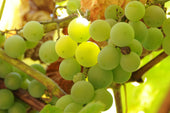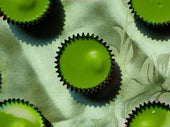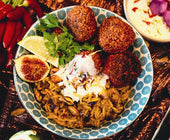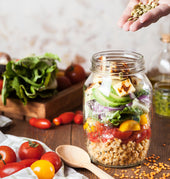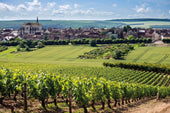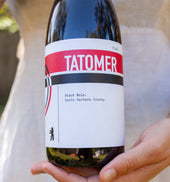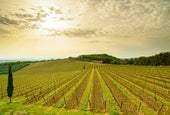
At Long Last: American Holiday Wine Pairings

Thanksgiving is just around the corner, followed by the trifecta of winter holidays: Hanukkah, Christmas and New Year’s Eve. With the addition of Kwanzaa, the season of gratitude, gift-giving and feasting is upon us. Many holiday hosts are scouring the internet for new takes on traditional recipes — and the best wines to highlight those dishes.
How did the United States — a country founded by Pilgrims and molded by Puritans—beget a series of harvest and yuletide celebrations so closely associated with the enjoyment of wine?
It turns out that early Americans were, in fact, not teetotallers at all. US Government figures from 1790 show that early Americans drank an average of thirty-four gallons of beer and cider, five gallons of distilled spirits, and one gallon of wine per year. (Today’s figure is a far more modest 2.3 gallons per capita.) Back then, alcohol was a safer choice than frequently non-potable water, and colonists of all ages drank from sunup to sundown— even more so at any kind of celebration.
Early attempts by the Puritans to caution against this insalubrious behavior included canceling Christmas in Massachusetts between 1659 and 1681. The yuletide was marked by episodes of public drunkenness that had housewives storming public taverns to drag their spouses — and what was left of their income — away from disaster. The nation’s first organized attempt at curbing holiday alcohol consumption was the 1830s temperance movement. The movement tied Christmas more closely to its Christian origins and centered celebration on worship and family gatherings. The “tempering” effects were short-lived and soon superseded by the Civil War. Thereafter, Americans were again celebrating holidays with gusto — and adult beverages.
As of 1849, the nation began incubating its own wine industry in the new state of California. For once, Americans had a domestic alternative to imported European wines. American wines quickly improved in quality, and by the end of the 19th Century were gaining international attention.
Then came disasters both natural (phylloxera) and governmental, when prohibition outlawed the manufacturing of alcoholic beverages. The thriving American wine industry was decimated by the time of Prohibition’s repeal in 1933.
It wasn’t until after WWII that Americans began to seek out wine, in addition to fortified wines and spirits, to pair with their winter celebrations. Reasons for this wine Renaissance are attributed to a number of factors: returning Veterans who had a taste for European food and wine, world travel made accessible by jet aircraft for those who could afford it, European countries eager to export wine to boost their economies, and the recovery of the California wine industry from a 13-year hiatus.
What followed was an extended “wine appreciation” class for the American wine drinker. The first forays of holiday food and wine pairings reflected a more naive palette. Sweet German wines such as Moselle, and dryer white wines such as Semillon and Sauvignon blanc gained popularity in the 1950s, along with Claret and Burgundy.
With the dawn of the 60s, boomers broadened their tastes. Ernest and Julio Gallo, Paul Masson and Italian Swiss Colony made a killing in the following decades by turning wine drinking into an affordable weeknight activity with Rosés, Burgundies and Sparkling Wines from California.
Things really took off after the “Judgement of Paris'' in 1976, when American wines again achieved international recognition. Since then, Americans’ growing interest in wine has been incorporated into their lives and their holiday celebrations.
Thanksgiving Dinner, that most American of holidays, had wine served with it even before it became an official national holiday in 1864. (A bill of fare for a Thanksgiving Dinner in Connecticut in 1817 included 150 gallons of wine, in addition to 5,500 turkeys.)
Today, it is the most alcohol-centric holiday due to copious eating, sporting events (the earliest Thanksgiving-associated football games began in the 1890s), and family gatherings.
As a harvest celebration whose centerpiece is the consumption of carefully prepared food items, it is wine’s raison d’etre. For the past two decades, Pinot Noir and Sauvignon Blanc have been the go-to wines for a Turkey dinner. But, American tastes have matured and the wine selections have broadened. French Champagne and Rosés are often paired with starters, and a light Beaujolais, bold Zinfandel or Rhone-style red might make it to the table, depending on the hosts’ tastes.
Christmas dinner, too, has come a long way from mulled wine or the bottle of Paul Masson on the table. Guests now enjoy starters with Prosecco, Cremant or Champagne. Traditional Christmas beef is highlighted by Cabernet Sauvignon, Bordeaux blends, Tempranillo or even Shiraz. And glazed ham has an array of unctuous white wine pairings such as Riesling or Gewurztraminer, in addition to the usual Beaujolais or Pinot Noir.
Hanukkah’s traditional oil-fried foods reflect the origins of the holiday — a celebration in honor of the miracle of the cruse of oil that kept the Menorah lit for 8 days. Celebrations have moved beyond serving the time-honored Manischewitz white and red wines and cordials. Potato latkes are now paired with Prosecco or Sauvignon Blanc. Kugel is enjoyed with Pinot Noir or Riesling, depending on its ingredients. And, the sweet jelly donut-like Sufganiyot is enhanced by Champagne.
Kwanzaa, America’s most recent cultural holiday, observes the passing of the year with a week of reflection, reaffirmation and thanksgiving. Traditional foods of the African diaspora are served; sometimes comfort foods like macaroni and cheese or glazed ham, or Soul foods like collard greens or fried catfish. Kwanzaa has grown in the country’s cultural awareness in parallel to America’s appreciation of wine. The holiday’s foods are served with wines that enhance their inherent flavors and characteristics: collard greens with Gewurztraminer or Riesling, Pinot Grigio with fried catfish, or Beaujolais with mac and cheese. With such an amazing and flavorful array of options, the sky's the limit for Kwanzaa food and wine pairings. An increasing number of black-owned wine companies also have offerings that add to the authenticity of this celebration.
And, of course, New Year’s Eve celebrations are inseparable from Champagne. The tradition originated in New York City — the center of America’s annual countdown, in 1902. Two Gallic brothers took over Delmonico’s 26th street location and opened up a French restaurant, Cafe Martin, that boasted 69 Champagnes on the menu. The Cafe promoted a “Champagne only” menu on New Year's Eve. Waiters received “kickbacks” from the wine importers for each cork popped. The trend soon spread to most New York restaurants with newspapers regularly reporting the amount of Champagne consumed on New Years Eve. Around the same time, in 1904, the Times Square New Year's Eve celebration was started, thus cementing the tie between Times Square, New Year’s Eve and Champagne.
Like so many things in American life, holiday food and wine pairings have been borrowed from somewhere else, assimilated, and then transformed to adapt to American tastes, ingenuity and imagination. They are uniquely American and traditionally untraditional.
 Patty Lyn Tweten is a writer, graphic designer and Pinot Noir vineyard owner. Working exclusively in the wine industry, her writing inspiration comes from visual design work and her own front yard. Website Facebook Instagram Linkedin
Patty Lyn Tweten is a writer, graphic designer and Pinot Noir vineyard owner. Working exclusively in the wine industry, her writing inspiration comes from visual design work and her own front yard. Website Facebook Instagram Linkedin







